Diplomatic Bluebook 2016
Chapter 3
Japan’s Foreign Policy to Promote National and Worldwide Interests
2.Cultural Diplomacy
(1) Overview
MOFA and the Japan Foundation (JF) operate various projects to promote positive images of Japan in foreign countries, boost brand images of the entire Japan, enhance the understanding of Japan, and foster pro-Japanese individuals and groups for the future. For example, the “cultural projects of the diplomatic missions overseas” introduce a wide range of Japanese cultures from traditional to contemporary, animation, manga, fashion, architecture, and design. MOFA is implementing the “Japan Brand Program” to promote diverse attractiveness of Japan from craftsmanship aiming at a fusion of tradition and present-day to advanced technologies, through lectures and workshops by specialists dispatched from Japan. This program is meant to pave the way for international exchanges.
In addition, in order to cultivate understanding and support for Japan and to promote better understanding of Japan through Japan studies MOFA implements the following activities: provision of information on studies in Japan through Japan’s diplomatic missions overseas; building alumni networks of former foreign students in Japan; collaboration with the “JET Programme” which invites young people from abroad to local governments in Japan, exchange programs for young people and adults from Asia, North America and Europe; sending visiting professors to universities and research institutions overseas; and grant program for research activities.
Promoting Japanese language education overseas helps foster future leaders who will build a bridge between Japan and overseas, deepen understanding towards Japan, and lay a foundation for friendship with other countries. Therefore, MOFA engages in sending Japanese language specialists overseas, providing trainings for foreign Japanese language teachers in Japan, and developing Japanese language teaching materials, with the Japan Foundation.
It is also important to enhance the presence of Japan in the area of sports for the successful delivery of the 2020 Olympic and Paralympic Games in Tokyo. As a part of the “Sport for Tomorrow” program, MOFA implements the following activities: various sport exchange/contribution projects in many countries; the dispatch and invitation of sport athletes/instructors by MOFA, by JICA volunteers or by the Japan Foundation; and the provision of sports equipment and the improvement facilities.
In addition to these, using the budget allocated to strategic communications, MOFA intends to enhance support for researchers of Japan studies, expand personal exchange and sports exchange programs and further promote Japanese language education.
In cooperation with the UN Educational, Scientific and Cultural Organization (UNESCO), earnest efforts are being made to preserve the world’s tangible and intangible cultural heritage (see (7) for details). In 2015, the “Sites of Japan’s Meiji Industrial Revolution: Iron and Steel, Shipbuilding and Coal Mining” was inscribed on the World Heritage List.
(2) Culture Program
It helps maintain and improve Japan’s presence in the international community to boost understanding towards Japan among foreign nationals who form the foundation of public opinion and policy making as well as to make Japan’s image even more positive. With this importance in mind, MOFA engages in promoting diverse attractiveness of Japan through diplomatic missions overseas and the Japan Foundation.
The Japan Foundation Asia Center steadily implements “WA Project: Toward Interactive Asia through Fusion and Harmony” announced by Prime Minister Abe in December 2013 with two main pillars of support for Japanese language education and interactive arts and cultural exchange projects. Through the “NIHONGO (Japanese language) Partners” program, which is the core to support Japanese language education, 100 teaching assistants in total were dispatched to secondary education institutions in five countries of the Southeast Asia, and implemented the exchange program through the introduction of Japanese culture as well as Japanese language education in FY2014. As a result, about 98% of officials of schools, where the “NIHONGO Partners” were dispatched, highly evaluated the program, saying its activities contributed to the increased motivation for studies of students. In FY2015, the NIHONGO Partners program is planned to expand to eight countries in the Southeast Asia, with more than 200 partners to be sent. In the end, more than 3,000 persons are expected to be sent to ten Southeast Asian countries by 2020.
 NIHONGO Partners to be dispatched to Thailand and Vietnam (June, training before dispatch at the Japan Foundation Japanese-Language Institute, Kansai)
NIHONGO Partners to be dispatched to Thailand and Vietnam (June, training before dispatch at the Japan Foundation Japanese-Language Institute, Kansai)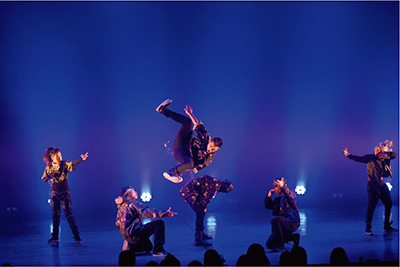 Dance groups of Japan and the Southeast Asia give performance as a part of “Dance Dance Asia” in Tokyo (October, Tokyo)
Dance groups of Japan and the Southeast Asia give performance as a part of “Dance Dance Asia” in Tokyo (October, Tokyo)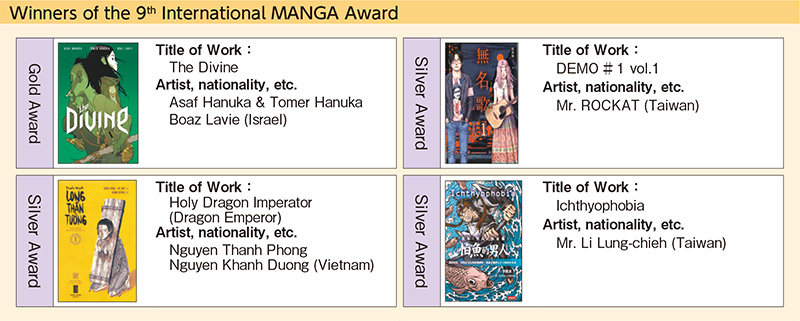
As part of the interactive arts and cultural exchange program, the Japan Foundation Asia Center implemented “Time of Others,” which introduced works by about 20 artists, mainly young ones, in Asia Oceania, and “Dance Dance Asia,” which aimed to connect Asian countries through street dances. The Japan Foundation also introduced Asian movies to Japan in collaboration with the Tokyo International Film Festival and held the Japanese Film Festival in Cambodia. In addition, in the field of sports, exchange project in football with the Southeast Asian countries were implemented in cooperation with J League as a part of “Sport for Tomorrow.” Japan tries to expand the program to various fields.
The International Manga Award was launched in 2007 by MOFA with the aim of rewarding manga creators who contributed to the spread of manga culture overseas. The 9th International Manga Award of 2015 received 259 entries from 46 countries and regions, and the Gold Award went to the work of an Israeli applicant. This is the first time for the Israeli to be awarded and indicates the world-wide spread every year of Japanese pop culture such as animation and manga.
MOFA conducts large-scale and comprehensive programs in commemorative years celebrating diplomatic events in cooperation with governmental and private organizations through mutual visits of dignitaries, various conferences and public relations/cultural projects, aiming for effective promotion of the understanding of Japan. 2015 was the as Japan-SICA Friendship Year the following commemorative events took place: Ishimi Kagura performance was conducted in Costa Rica, Honduras, El Salvador and Guatemala; Ocarina performances in Nicaragua, Panama and Dominican Republic. These led to promoting a variety of Japanese culture by highlighting Japan’s local attractiveness.
(3) People-to-People Exchange and Exchange in the Area of Education
MOFA carries out a number of invitation projects to build personal relations and promote the understanding of Japan by foreign nationals who have a great influence on shaping public opinion and policy making process and who are expected to play a leading role in the future. Also in the area of education and sports, MOFA is in charge of various activities to promote exchanges between wide ranges of people. These projects not only promote mutual understanding and friendly relationships, but also increase Japan’s presence in the international community and as a rather significant consequence bring diplomatic benefits adding to the national interest of Japan.
A. Exchange with foreign students
MOFA actively introduces the attractiveness of studying in Japan to foreign students and opportunities to study in Japan through diplomatic missions overseas. It also implements application and selection procedures to accept competent students from around the world as the Government of Japan (MEXT) Scholarship students. Furthermore, it is making efforts to maintain relations with former foreign students who have returned to their home countries through “Japan Alumni Associations” and to foster pro-Japanese individuals and groups.
B. JET Programme (The Japan Exchange and Teaching Programme)
The “JET Programme” was launched in 1987 to improve foreign language educations and promote international exchanges in local areas. The Programme received 4,786 participants from 43 countries including 1,958 new participants and dispatched them all over Japan in FY2015. In this program managed by the Ministry of Internal Affairs and Communications, MOFA, the Ministry of Education, Culture, Sports, Science and Technology (MEXT), and the Council of Local Authorities for International Relations, local governments invite young foreign nationals to Japan and appoint them to a post in the local governments and schools. MOFA is responsible for the application and selection process at diplomatic missions overseas, pre-departure orientation and support for the activities of the JET Alumni Association (JETAA, which has about 28,000 members). JETAA introduces Japan in their countries, and many former JET participants are successful in various fields as pro-Japanese in different parts of the world. Former JET participants are valuable human/diplomatic assets for Japan.
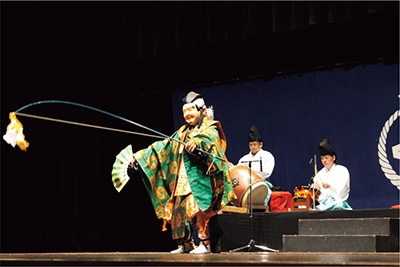 Iwami Kagura performance (program: Ebisu) (June 1-2, Guatemala)
Iwami Kagura performance (program: Ebisu) (June 1-2, Guatemala) Iwami Kagura (shinto music and dance performance) Lecture (May 30, ElSalvador)
Iwami Kagura (shinto music and dance performance) Lecture (May 30, ElSalvador)C. Sport exchange
Sport enables communications beyond language and can be an effective tool for promoting friendly relations and the understanding of Japan. As a host country of the 2020 Olympic and Paralympic Games in Tokyo, Japan is attracting much interest from foreign countries. The Government of Japan implements “Sport for Tomorrow (SFT)” program as an international cooperation through sport in January 2014. This program includes various sport exchange/contribution, promotional support, and human resource development projects in different countries, with the aim of spreading the value of sport by 2020, targeting over 10 million people in more than 100 countries. From FY2015, MOFA carries out the “Projects for Sports Diplomacy Enhancement” which enables dispatch and invitation of athletes and sports instructors, provision of equipment, promotion of sport diplomacy , and other exchanges through sports in a more prompt and effective manner in response to requests from governments and sports associations. These SFT projects have enhanced presence of Japanese sports organizations in the international sport community.
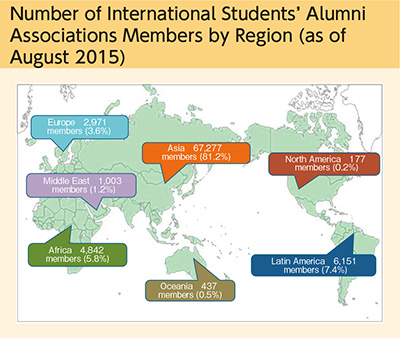
 Symposium on Monozukuri held by Association of Indonesian Alumni from Japan (PERSADA) (December, Darma Persada University, co-hosted by ASJA and ASCOJA)
Symposium on Monozukuri held by Association of Indonesian Alumni from Japan (PERSADA) (December, Darma Persada University, co-hosted by ASJA and ASCOJA)
 JET Programme participants just before departure (July 31, San Francisco)
JET Programme participants just before departure (July 31, San Francisco)(4) Exchange in the Intellectual Realm
A. Japanese studies
MOFA comprehensively supports a range of overseas research activities related to Japan’s politics, economy, society and culture. In FY2015, MOFA provided various forms of support through the Japan Foundation. These included sending visiting scholars, enhancing the collection of books on Japan and providing research grants to 65 institutions of Japanese studies in 26 countries and regions, such as universities and research institutions which are considered as Japanese studies hubs. Also, fellowship status was granted to 182 researchers in Japanese studies from 44 countries/regions, including those who were granted in the previous year. This helped the researchers conduct research and study activities in Japan (including the scheduled one in the 4thquarter of FY2015). MOFA also helps academic societies to promote network building among researchers and research institutions on Japan in different countries and regions. In addition, MOFA made contribution to American universities which are core centers on Japanese studies in order to establish professorships specializing in Japanese politics and foreign policy.
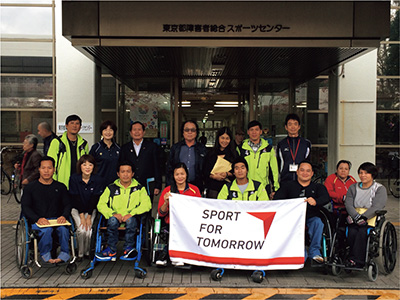 Invitation of Vietnamese physically handicapped athletes (November)
Invitation of Vietnamese physically handicapped athletes (November)B. Intellectual Exchanges
MOFA implements intellectual exchange projects, putting emphasis on cooperative work and exchange with other countries. Specifically, MOFA implemented seminars and symposia on common international agenda, and programs to deepen the understanding of modern Japan at major universities overseas through the Japan Foundation. MOFA planned and supported exchange programs to strengthen relationships and deepen mutual understanding through holding conventions in various fields and at various levels in cooperation with NPOs and other institutions.
C. U.S.-Japan Conference on Cultural and Educational Interchange (CULCON)
CULCON is a public-private binational advisory panel comprised of experts from Japan and the U.S. to discuss issues on educational and cultural exchanges between both countries. With a view to achieving the goal of “doubling two-way student exchanges by the year 2020,” which was set by CULCON and mentioned in the Joint Statement of the U.S.-Japan Summit Meeting in April 2014, the CULCON Educational-Exchange Review Committee was established. In September 2015, CULCON Special Seminar was held in Washington DC (U.S.) with the attendance of U.S. Congressman Mr. Joaquín Castro, co-Chair of the U.S.-Japan Caucus, to have discussions on topics such as the diversity in the U.S.-Japan exchanges. In addition, CULCON has actively discussing how to further enhance the bilateral exchanges and launched Ad-hoc Steering Operations Committee and Japanese Language Education Committee.
D. Cooperation with the UN University (UNU)
The Government of Japan invited UNU, which contributes to the international community through study and research on global issues and human resources development, to locate its headquarters in Tokyo, Japan and has provided various cooperation and support for 40 years. UNU, in collaboration with Japanese universities and research institutions, is engaged in international issues, on which Japan focuses, such as peace, development, and environment, and contributes to dissemination of the policies of the Government of Japan. UNU established Master’s and Doctoral Programmes in 2010 and 2012, respectively, to improve its global human resources development programs.
(5) Promotion of Japanese Language Education
The interest in Japanese language has been increasing among people, especially the youth overseas as Japanese companies have been expanding their operations overseas and Japanese pop culture is getting more familiar worldwide along with the globalization of Japanese economic structure. Further promotion of the Japanese language overseas leads to creating a favorable international environment for Japanese people and companies. Currently, about 3.99 million people in 136 countries and regions overseas are learning the Japanese language (“Survey on Japanese-Language Education Abroad 2012” by the Japan Foundation). The number of learners has been steadily increasing since the first survey in 1979 by more than 30 times. In 2015, approximately 750,000 examinees (the number of applicants, including tests conducted in Japan) took the Japanese-Language Proficiency Test of the Japan Foundation in 264 cities of 69 countries and regions worldwide.

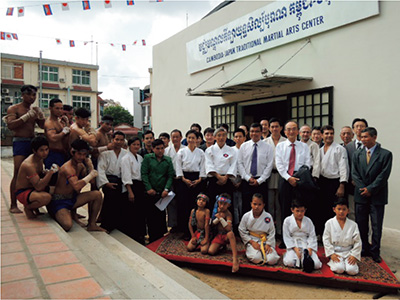 The inauguration ceremony of the Cambodia-Japan Traditional Martial Arts Center in Phnom Penh constructed by Grant Assistance for Cultural Grassroots Projects (December 12)
The inauguration ceremony of the Cambodia-Japan Traditional Martial Arts Center in Phnom Penh constructed by Grant Assistance for Cultural Grassroots Projects (December 12)MOFA engages in accommodating various needs of Japanese-language educational institutions through the Japan Foundation (JF): Specifically through dispatching of Japanese language specialists overseas, providing trainings in Japan for Japanese teachers and foreign diplomats overseas, developing teaching materials and promoting the “JF Japanese Language Education Standard.” Moreover, the JF aims to further increase the number of Japanese language learners overseas through further utilization of audio-visual teaching materials, such as learning aid websites which use animation and manga, and through directly managed Japanese language courses.
The JF has also been making efforts to create and expand the “JF Nihongo Network (aka; Sakura Network),” mainly at the JF overseas offices and universities where Japanese language specialists are dispatched since FY2007, in order to develop programs for Japanese language education responding to various needs of each country/region and to enhance partnerships among relevant institutions. In 2015, universities and Japanese language teachers associations, which are cores in implementing Japanese language education, are registered as new network members. The JF strives to further increase the number of network participating members from the previous status of 127, to about 280 and enhance assistance to these members.
(6) Cultural Grant Aid
The Government of Japan provides Cultural Grant Assistance, as part of Official Development Assistance (ODA) to promote culture and higher education in developing countries thereby enhancing mutual understanding and friendly relations between Japan and developing countries. The activities implemented in 2015 include nine General Cultural Grant Assistance Projects (total of 530 million yen) and 22 Grant Assistance for Cultural Grassroots Projects (total of 210 million yen). In 2015, General Cultural Grant Assistance put emphasis on the preservation of the cultural heritage and the promotion of broadcasting programs, with Grant Assistance for Cultural Grassroots Projects putting emphasis on the fields of sports and the Japanese language.
(7) Cooperation through United Nations Educational, Scientific and Cultural Organization (UNESCO)
Japan is actively involved in various projects of UNESCO in the areas of education, science and culture, etc. UNESCO is the first international organization of which postwar Japan became a Member State in 1951. Since then, UNESCO has been cooperating with Japan in the support for education, science, and culture, etc. in developing countries.
In the field of culture, Japan offers active cooperation for safeguarding and promoting tangible and intangible cultural heritage in the world, and support in the field of human resources development as the pillars. At the same time, Japan actively participates in the international framework for safeguarding of cultural heritage. As part of such activities, Japan established two Japanese Funds-in-Trust at UNESCO, aiming for the safeguarding of tangible and intangible cultural heritage. Through the UNESCO Japanese Funds-in-Trust for the Preservation of the World Cultural Heritage, and with Japanese experts playing a leading role, Japan supports many projects for conservation and restoration of sites such as the Angkor Wat in Cambodia and Tombs of Buganda Kings at Kasubi in Uganda, while contributing to the development of human resources so that local people can protect their cultural heritage by themselves in the future. Especially, Japan continuously supports the preservation and restoration of the Angkor Wat in Cambodia, which started in 1994, with the fourth phase started in 2012. Through the UNESCO Japanese Funds-in-Trust for the Safeguarding of the Intangible Cultural Heritage, the following projects have been implemented; handing down of traditional performing arts such as music and dance, and traditional crafts in developing countries to the next generation; development of domestic institutions and capacity building of relevant parties to enhance countries’ ability to protect intangible cultural heritage by themselves.
In the area of education, Japan sets up the Japanese Funds-in-Trust for the Capacity-building of Human Resources, which aims to develop human resources in developing countries, and provides support for human resources development mainly in the area of education, through promoting “Education for All (EFA)” led by UNESCO, etc. As for “Education for Sustainable Development” (ESD),” Japan provided various support to develop the “Aichi Nagoya Declaration” adopted in the “UNESCO World Conference on ESD,” co-hosted with UNESCO, in Okayama and Nagoya in November 2014. Moreover, in September 2015, the prize winners of the newly established UNESCO-Japan Prize on ESD were awarded for the first time and the ceremony was held at the General Assembly of UNESCO in November 2015.
In addition, Japan contributed a total amount of 5 million US dollars to UNESCO: in March 2015, 4.5 million US dollars to the “emergency assistance to Secondary Schooling for Girls of IDP Communities,” which UNESCO implements in Iraq, and 500 thousand US dollars to the “Urgent Capacity Development for Managing Natural Disaster Risks of Flash Floods in Egypt, Jordan, Sudan, and Yemen.”
A. World Heritage Convention
The World Heritage Convention aims to protect cultural and natural heritage, which is regarded as the heritage of all mankind. Japan became a party to the Convention in 1992 (As of December 2015, the number of parties to the Convention is 191). The ones listed on the “World Heritage List” are so-called “World Heritage” sites. The sites are classified into “Cultural Heritage” (monuments and remains), “Natural Heritage” (natural areas) and “Mixed Heritage” (having elements of both cultural and natural). As of December 2015, a total of 1,031 World Heritage sites are inscribed on the World Heritage List. At the 39th session of the World Heritage Committee held in Bonn, Germany in 2015, it was decided to inscribe the “Sites of Japan’s Meiji Industrial Revolution: Iron and Steel, Shipbuilding and Coal Mining” on the World Heritage List. It has raised the number of the World Heritage sites in Japan to 19: 15 Cultural Heritage and 4 Natural Heritage. Japan served as a member of the World Heritage Committee from 2011 to 2015.
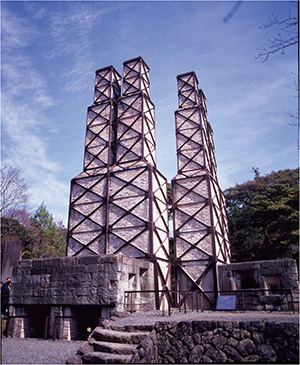 Sites of Japan’s Meiji Industrial Revolution: Iron and Steel, Shipbuilding and Coal Mining (Nirayama Reverberatory Furnaces)
Sites of Japan’s Meiji Industrial Revolution: Iron and Steel, Shipbuilding and Coal Mining (Nirayama Reverberatory Furnaces)B. Convention for the Safeguarding of the Intangible Cultural Heritage
The Convention for the Safeguarding of the Intangible Cultural Heritage aims to develop an international system for safeguarding intangible cultural heritage, such as traditional performing arts and traditional craftsmanship techniques (As of December 2015, the number of parties to the convention is 163). Japan, which has rich experience in safeguarding intangible cultural properties, has provided active contributions playing the role of engine for developing the Convention by taking initiative to form the major sections of the operational guidelines for the implementation of the Convention. The total of 22 elements of intangible cultural heritage in Japan are inscribed on the “Representative List of the Intangible Cultural Heritage of Humanity” established in accordance with the Convention. It includes: “Nôgaku theatre”, “Ningyo Johruri Bunraku puppet-theatre” and “Kabuki theatre,” which have been proclaimed by UNESCO as “Masterpieces of the Oral and Intangible Heritage of Humanity.” Currently, the nomination file of “Yama, Hoko, Yatai, float festivals in Japan,” which was submitted by Japan is under the evaluation process; this is the extension of “Yamahoko, the float ceremony of the Kyoto Gion festival” and “Hitachi Furyumono,” which were inscribed in the list in 2009, incorporating similar festivals existing all over Japan.
C. UNESCO Memory of the World Programme
The UNESCO Memory of the World Programme was established in 1992 to preserve and promote valuable historical materials. As of December 2015, 348 items have been inscribed. The “Archives of Toji temple contained in one-hundred boxes” and the “Return to Maizuru Port—Documents Related to the Internment and Repatriation Experiences of Japanese (1945-1956),” which were submitted for the inclusion by Japan, were inscribed in October 2015. The number of registered Japanese items is five in total. At the same time, it was announced that documents relating to the “Nanjing Incident” that had been submitted by organizations in China were also inscribed. It is clear that Japan and China have different views regarding the issues related to the submitted documents. It is extremely regrettable that those documents were submitted for the inclusion and inscribed based on China’s unilateral assertions.
Japan, has been making its atmost effort to improve the system so that the programme become more harmonized with the spirit of UNESCO.
What do you think is the relation between sport and diplomacy?
Sport is a very effective “tool” for promoting international contributions and exchanges as it is familiar to everyone and it has the power to leave an impression on many people. Toward the 2020 Olympic and Paralympic Games in Tokyo, the Ministry of Foreign Affairs (MOFA) launched “Projects for Sports Diplomacy Enhancement” in FY2015 to steadily implement the measures entitled “Sport for Tomorrow” to make international contributions in the area of sport. In the project, MOFA has been inviting and dispatching athletes and coaches, as well as providing assistance with the transportation of sports equipment to developing countries. By placing sport as an important element of diplomatic relations, the scope of diplomacy is broadened, and synergy effects of further recognizing the value of sports can be expected. Here is an example of an invitation project- a sailing team from the Philippines was invited.
Facilitating international exchange in Enoshima and Hayama, with a sailing team from the Philippines!
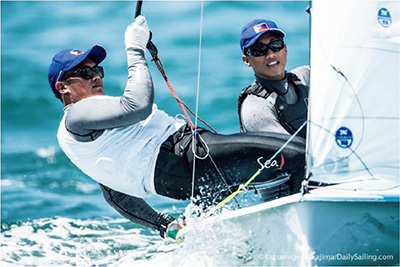 In the “2015 Kanto 470 Championship,” 5th place was achieved among the total of 85 competing boats.
In the “2015 Kanto 470 Championship,” 5th place was achieved among the total of 85 competing boats.Photo: Kazushige Nakajima/ DailySailing.com
Given the sports-related budget size and the lack of sailing population in the Philippines, such opportunities for its athletes to take part in competitions abroad to compete with a large number of athletes and improve their skills are invaluable. Therefore, MOFA invited five sailing athletes and a coach from the Philippines to a training course in August 2015, as a part of the Projects for Sports Diplomacy Enhancement in cooperation with the Japan Sailing Federation. A joint training was conducted for the athletes together with the Japanese university students. They learned practical skills and participated in a competition held at Enoshima. They also deepened friendships with the Japanese students and staff through the training and competition. On the final day, one of the athletes said, “I was glad they were very kind to us (despite not knowing us well). The opportunity turned out to be a long lasting memory for both parties from the Philippines and Japan. It can be said that the event was an opportunity to deepen the Japan-Philippines relations through sport, which is a relatively new viewpoint.
Toward the 2020 Olympic and Paralympic Games in Tokyo.
It is possible to spread the values of sport in the international community through such initiatives, thereby conveying Japan’s efforts and enthusiasm toward the 2020 Olympic and Paralympic Games in Tokyo. Each of the exchanges is low profile, but the accumulated efforts lead to a positive image of Japan, serving as the foundation to support diplomacy.
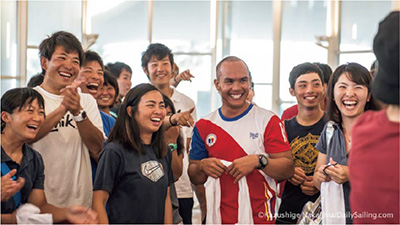 Photo: Kazushige Nakajima/ DailySailing.com
Photo: Kazushige Nakajima/ DailySailing.comAside from the above, MOFA made the following international contributions globally: Invitation of a baseball team from Czech Republic, a table tennis team from India, and a gymnastics team from Senegal and a para-swimming and para-powerlifting team composed of the disabled athletes from Vietnam, dispatch of judo leaders to China and Papua New Guinea, as well as the assistance with the football equipment transport to the Middle East and Asian countries. If these efforts continue, it would not be a dream for these individuals so trained and supported by Japan to become top athletes in their respective countries and to come to Japan in 2020 for the Tokyo Olympic and Paralympic Games.
●Interview with Mr. Michael Leitch (Captain of the Japanese National team and Member of New Zealand Chiefs)
―Did you feel a deepening of understanding between countries or people through international sports activities? Do you know of any good cases of international exchange and cooperation? What do you think is necessary for Japanese people to perform well in the world?
Mr. Leitch:I felt that Japanese and New Zealanders are alike in personality and their way of thinking, and therefore can understand each other to some extent. From the viewpoint of sports exchange, I think Japanese teams should have more games with foreign teams to accumulate experience and gain confidence. In order to perform well in the world, I think it is very important that Japanese people behave in a flexible manner without sticking to a pattern. Speaking of rugby, I think Japanese players should go abroad to accumulate various experience. I think there is not that much of a difference in the level of rugby between Japan and New Zealand, so I feel Japanese players should have more confidence. I think the strengths unique to Japanese players are patience and tenacity, as well as enthusiasm at training. In addition, Japanese players have excellent technique. As you saw in last year’s Rugby World Cup, the Japanese team became a very strong team, thanks to the technique of Japanese players mixed with the power of foreign players.
―The Rugby World Cup 2019 is to be held in Japan. What do you expect foreign visitors to see in Japan What do you like about Japan, Mr. Leitch?
Mr. Leitch:I think hospitality in Japan is amazing, so I would like them to have a taste of that hospitality. In addition, since each of the cities providing venues for the Rugby World Cup is attractive, I do not think foreign visitors or players will get bored with staying there. I think attractive points shown by Japanese people are kindness, good manners, politeness and effort not to bother others.
―What difficulties did you experience while you were playing for high school and university teams in Japan?
Mr. Leitch:I had difficulties in the relationship between seniors and juniors. Depending on the situation, I could sometimes accept the hierarchical relationship, but sometimes not. There were some times when I felt that my seniors were not right.
―What do you want to say to people thinking of visiting Japan in the future?
Mr. Leitch:I want them to enjoy Japan. In particular, local food and drinks such as shochu are delicious in Japan, so I want them to try them for themselves.

●Message from Mr. Ayumu Goromaru (Vice captain of the Japanese National Team and Member of the Queensland Reds, Australia ) ~ One for all, All for one, and Challenge to be the World’s Best ~

In rugby, the expected roles and gameplay varies greatly depending on the player in each position. You cannot achieve victory if you are lacking in any position.
Big players form a scrum to get the ball. The ball is then passed backward by a small player. When a fast-running player who has received the ball is tackled, a big player runs full speed behind him. In this way, when each player performs his role, the team can achieve victory.
The ability to read the other player’s intentions and react accordingly. The sense of victory or the disappointment of defeat can be felt more strongly than in any other sport. This is the good thing about rugby. All players work hard together toward one goal, taking advantage of their individual skill set, allowing for personal growth.
I’ve experienced these situations many times in rugby. In particular, I was able to share in the ultimate joy with my teammates when our Japanese national team beat South Africa, Samoa and the U.S. teams respectively, in the 2015 Rugby World Cup.
I am very grateful to all the people who have helped support these victories by cheering me on. These include the head coach, coaches and team staff, supporters, sponsors and my family. I believe it is my mission to inform the world of the enjoyment of rugby and sports, to inspire the next generation who take over to aim higher while still holding on to that feeling of gratitude.
Since February 2016, I have been playing for the Queensland Reds, in Brisbane, Australia. Despite the change in the country and the team I play for, the rugby spirit of playing together with other team members is exactly the same. I am experiencing the international nature of the sport of rugby. Playing abroad is a new challenge, but I want to continue to perform well without being influenced by the environment, whether in or outside of Japan. These are the values I carry with me into each match.

●Interview with Mr. Fumiaki Tanaka (Member of the Japanese National team and the Highlanders, New Zealand)
―A growing number of Japanese athletes go abroad to play. What do you think is necessary for Japanese to perform well in the world? Do you have any message you want to convey to Japanese children?
Mr. Tanaka:”English” and “confidence in yourself.”
English is an important tool for communication. In order to do well overseas, I think it is important to communicate in English to tap into your own potential. As I had a very hard time with English, I want the Japanese children shouldering Japan’s future to study English aggressively.
To demonstrate good performance on the world stage, I think it is very important that you should have “confidence” in playing without worrying about hierarchical relationships and what others think.
The strength of Japanese athletes is that they can withstand hardship. The practice roster prepared by our head coach Eddie Jones was a very severe one, but we were able to endure it because we were Japanese (laughter). Thanks to his severe training, we greatly developed our ability.
―During the Rugby World Cup 2019 to be held in Japan, what do you want foreigners visiting Japan to see?
Mr. Tanaka:Japanese culture is popular overseas. I would like them to feel the wonders of Japan such as Japan’s unique culture including traditional buildings and Japanese food culture. I recommend they try the delicious food culture, such as a wide range of Japanese and international cuisines including Japanese barbecue “Yakiniku”, sushi and cheap-and-fast foods. I also encourage them to come to the rugby venues (12 cities) and discover the beauty of local cities in Japan.
I would like Japanese people to communicate actively with foreign visitors. When you see those visitors losing their way or getting puzzled on the street, I would like you to demonstrate the hospitality of omotenashi - without pretending not to see them - and let them go back to their countries with a good impression.
―What troubles did you have and what efforts did you make to overcome them in your career as a player (including in your school days)?
Mr. Tanaka:I am rather short, so I was likely to be seen as an easy target because of that. I made continued efforts in training myself to overcome that handicap. I had a mortifying time being excluded from matches, but I made efforts not to waste a variety of experiences to build on for the next step. It was very tough at the time, but I was able to play without losing myself. I think that it was good to have stayed true to myself without going astray.
―Any words for those who are thinking of visiting Japan?
Mr. Tanaka:I would like them to talk to and communicate with many Japanese people, because I think that mutual understanding can be deepened by talking to each other.

Located in seven-hour drive to the north from Bangkok, the capital of Thailand. I am teaching at an integrated middle and high school in Uttaradit Province. There are thousands of durians in this town, but hardly seen any Japanese. Still, when I go to school for teaching, I hear the students cheerfully say “Good morning” in Japanese.
For the students, “NIHONGO Partner” is the first Japanese to meet. Some of them were too shy to make eye contact. But while we were spending time together through learning in class, having a meal and preparing for events, we got closer and built mutual trust. They now run towards me joyfully as soon as they find me.
I have one unforgettable memory. One day after school, one of the second-year high school students came to the teachers’ room. She asked me, “Please teach me calligraphy.” She told me that she would like to participate in and win a Japanese culture contest scheduled for the following month. I wondered what I should teach to a beginner who could not tell the difference of the front and back sides of Japanese paper for calligraphy in such a short term. Challenging days began for both of us. As she worked hard, she made remarkable progress day by day, through severe practice. When she handled the brush to form well-balanced strokes, we could not help but jump for joy.
But the reality was not so easy. At the contest that she tried with a confidence, she did not even get a prize, much less win it. I still remember clearly the moment when we embraced each other with a sense of disappointment. However, I was moved from the bottom of my heart to see her teaching calligraphy to younger students somewhat proudly. Having learned the pleasure of writing beautifully, she now fills her notebooks with beautiful letters.
Most of students associate Japan with animation, cartoons, cherry blossoms and Japanese food. They get information on the Internet, but it is a little biased. I thought that there was a kind of Japanese culture that could only be introduced by Japanese people, so I also worked on a plan for homestays to provide the students an opportunity to meet with more Japanese, in collaboration with Japanese university students studying in Thailand.
More recently, the students are increasingly motivated to learn Japanese language, saying “I want to make more efforts to study. The number of students who challenge the Japanese Language Proficiency Test is increasing two to three times. Some students got prizes in the national Japanese language contest, and now they are further working hard for the contest in the next year.
I hope that even just a little memory with Japanese people will remain in the minds of the students who will create the future! That is all I wish.
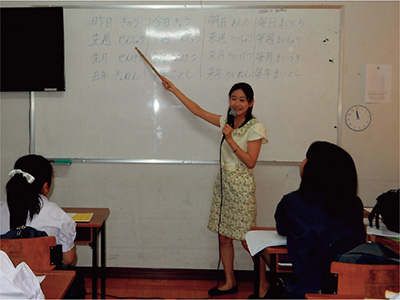 Japanese language class
Japanese language class Together with the teachers and second-year high school students in the classroom
Together with the teachers and second-year high school students in the classroom


